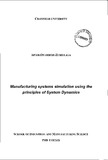JavaScript is disabled for your browser. Some features of this site may not work without it.
| dc.contributor.advisor | Baines, Tim | |
| dc.contributor.author | Oyarbide Zubillaga, A. | |
| dc.date.accessioned | 2017-07-03T09:08:42Z | |
| dc.date.available | 2017-07-03T09:08:42Z | |
| dc.date.issued | 2003-11 | |
| dc.identifier.uri | http://dspace.lib.cranfield.ac.uk/handle/1826/12141 | |
| dc.description.abstract | Manufacturing is the largest single contributor to the global economy. The evolution of consumer demands has pressurised companies into producing a larger variety of products, with improved specifications, reduced costs, and shorter lead times. In this context, companies have found simulation techniques useful in their manufacturing systems design processes; simulation based on Discrete Event Simulation (DES) is the preferred technique. The complexity of manufacturing systems, and the mechanisms of DES, means that the simulation task often consumes excessive time and resources, such as data, software, and training. Evidence suggests that an alternative modelling technique, named System Dynamics (SD), is also appropriate for conducting this task. SD has been applied successfully in other fields, where its graphical notation is considered beneficial. However, the lack of an SD tool that is tailored toward manufacturing systems has prevented industry from adopting this technique more extensively. This thesis determines the extent to which SD can provide a credible alternative to DES in the manufacturing system design process. Information concerning DES, SD and practitioners' needs was gathered from published literature and from an interview survey. A functional prototype of a tool based on the SD principles, but tailored to model manufacturing systems was then developed. Three case studies then provided valuable information concerning the requirements of industry and the capabilities of the SD technique. This research programme has found SD to be sufficiently accurate and quicker than DES tools under certain conditions, requiring less data and skills. In addition, the user interface appears to have had a significant impact on the lack of adoption of SD techniques within the manufacturing sector. Simp1ifications made by this technique can reduce both model building and model execution time, and thus, experimentation time. However, evidence suggests that DES is still more prevalent, and that further work is required to develop SD based tools tailored to manufacturing systems. Therefore, this thesis provides a much improved understanding of the capabilities of SD as an aid to manufacturing systems design. | en_UK |
| dc.language.iso | en | en_UK |
| dc.publisher | Cranfield University | en_UK |
| dc.rights | © Cranfield University, 2003. All rights reserved. No part of this publication may be reproduced without the written permission of the copyright holder. | en_UK |
| dc.title | Manufacturing systems simulation using the principles of system dy | en_UK |
| dc.type | Thesis or dissertation | en_UK |
| dc.type.qualificationlevel | Doctoral | en_UK |
| dc.type.qualificationname | PhD | en_UK |
